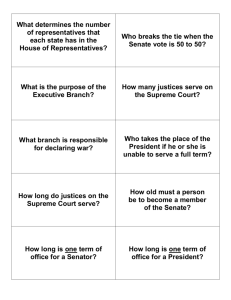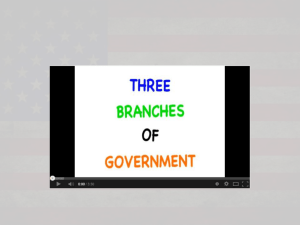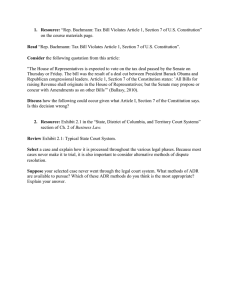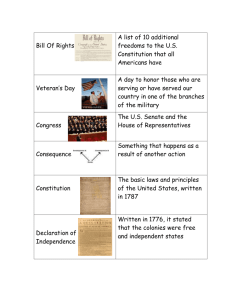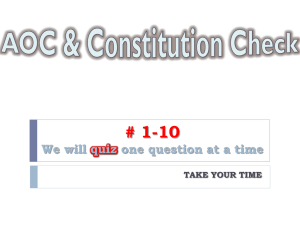3. American government
advertisement
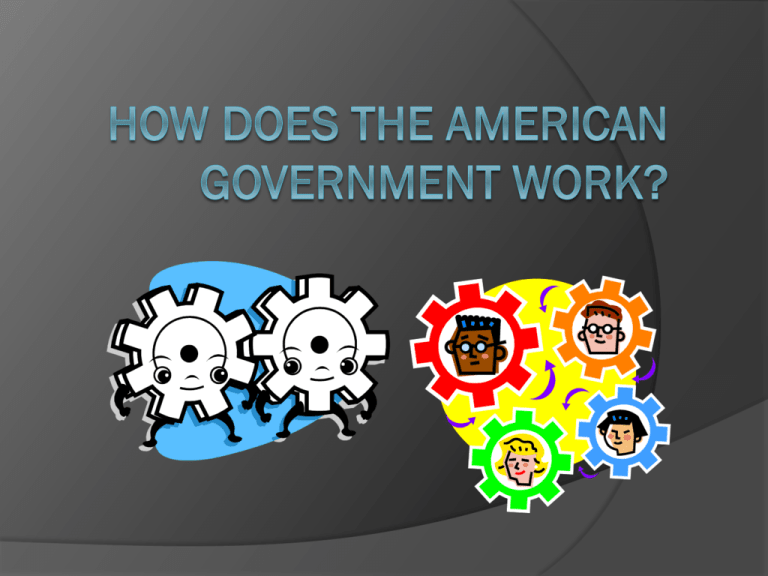
Can you name all the states of America? You have 5 minutes to name as many American states as you can! 50 States Alabama Kentucky New Mexico Tennessee Alaska Louisiana New York Texas Arizona Maine North Utah Arkansas Maryland California Massachuse Colorado Connecticut Delaware Florida Georgia Hawaii Idaho Illinois Indiana Iowa Kansas tts Michigan Minnesota Mississippi Missouri Montana Nebraska Nevada New Hampshire New Jersey Carolina North Dakota Ohio Oklahoma Oregon Pennsylvani a Rhode Island South Carolina South Dakota Vermont Virginia Washington West Virginia Wisconsin Wyoming Southern Slave states (grey) How does the US government work? There are 2 main political parties – the Democrats and Republicans. The presidential candidates are elected by State delegates of their parties at the National Convention. Party politics – post WWI Woodrow Wilson was a Democrat – his League of Nations proposal split the Party. Some believed his idealism was commendable while others believed he was giving too many concessions. The Republicans were not invited to negotiations which angered them. The Democrats were also split on the amendment of Prohibition (banning of alcohol) REPUBLICANS WON A LANDSLIDE VICTORY IN 1920 because they promised to: 1. RAISE TARIFFS 2.RESTRICT IMMIGRATION 3.HELP FARMERS Principles of American politics 1900s RUGGED INDIVIDUALISM AKA LAISSEZ FAIRE – whereby the American government had little involvement in the lives of citizens or how the economy was run. PROGRESSIVISM was a shift in this view towards greater democracy, honest government and more effective controls over business. During Wilson’s term more progressive policies were passed indicating the Democrat’s move away from Laissez-faire. RUGGED INDIVIDUALISM ACTIVE GOVERNMENT THE LEGISLATIVE BRANCH Makes the country’s laws House of Representatives THE EXECUTIVE BRANCH Administers the country Senate Secretaries – appointed by the President CONGRESS Vice-President – elected with the President THE PRESIDENT Elect Electoral Voters Elect THE PEOPLE THE JUDICIAL BRANCH Explains and interprets the laws and the Constitution THE SUPREME COURT Appointed by the President with the advice and consent of the Senate Elect NB The rules and arrangements for the Government of the USA shown here are laid down in the Constitution. This written document defines and limits the powers of the Federal Government and divides them between the Government’s three main branches – Legislative, Executive and Judicial Congress (Parliament) House of Representatives = Congressmen/congresswomen represent individual districts within each state Senate = 2 representatives from each state are in the Senate How are legal decisions made? Amendments to the constitution need to be passed by House of Representatives and the Senate, ¾ of States must agree for it to be passed. The Supreme Court have the final legal say over whether a proposal is deemed to be UNCONSTITUTIONAL (going against the American constitution) The American Government 1. What is meant by a Federal system of Government? 2. What is the role of the following within the American system of Government: a) Executive b) Legislature c) Judiciary? 3. What is the Constitution of the USA? 4. Why can the President often find it difficult to govern effectively? 5. What were the main differences between the Democrat and Republican political parties? End of Lesson quiz What is the constitution? 2. How much support is needed to pass an amendment? 3. How is Congress divided? 4. Who sits in the Senate? 5. Who sits in the House of Representatives? 6. Who are the two main political parties in America? 1.
